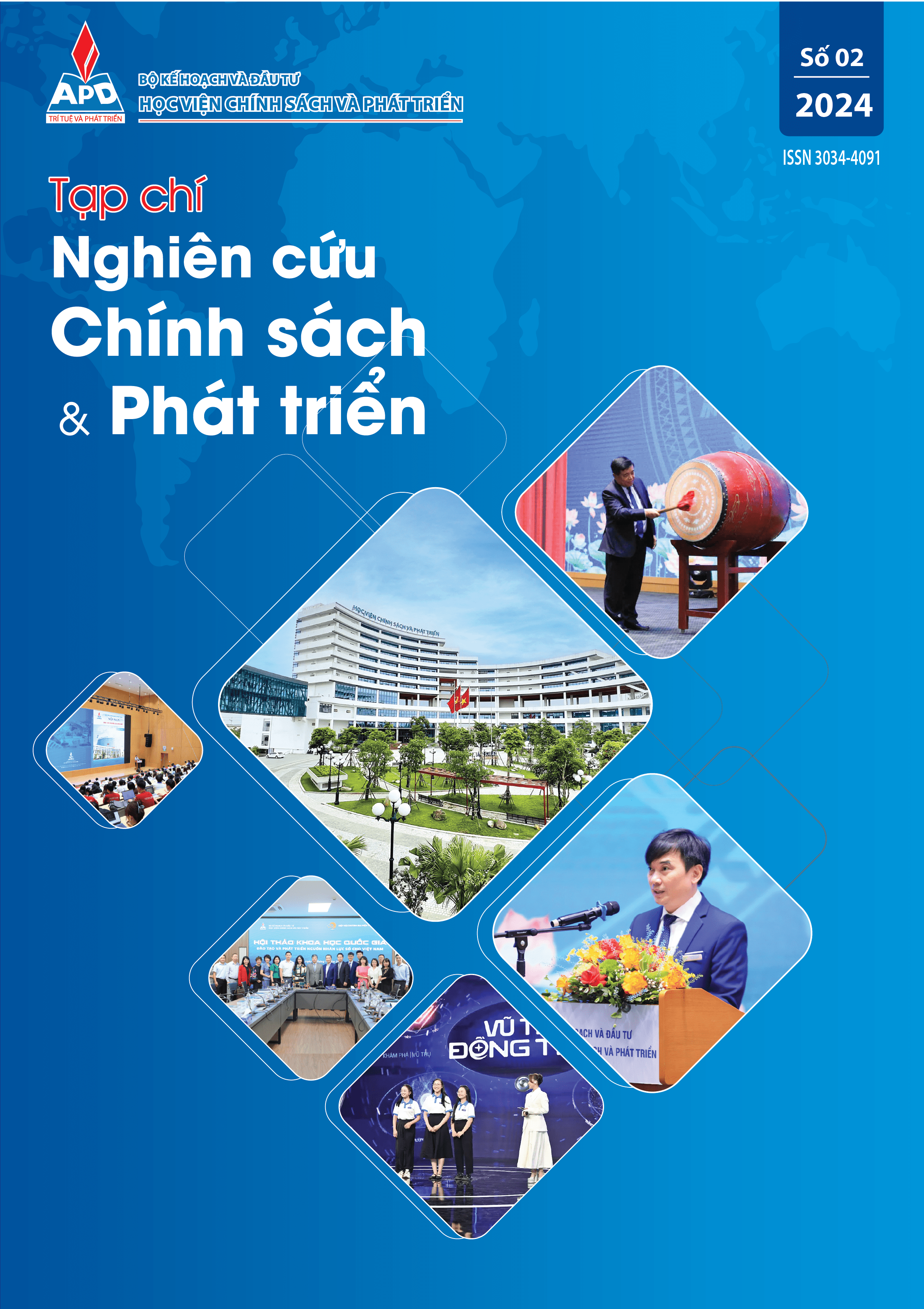Xác định mức độ ưu tiên của các yếu tố thúc đẩy đầu tư xanh của các doanh nghiệp xây dựng tại Hà Nội
Tải xuống
Đã Xuất bản
Cách trích dẫn
Số
Chuyên mục
Từ khóa:
Đầu tư xanh, thúc đẩy đầu tư, doanh nghiệp xây dựng, phát triển bền vững, phân tích AHPTóm tắt
Đầu tư xanh đang là xu hướng tất yếu của các doanh nghiệp xây dựng nhằm giảm thiểu các tác động biến đổi khí hậu và ô nhiễm môi trường hiện nay. Nghiên cứu ứng dụng phương pháp phân tích thứ bậc AHP để xác định mức độ ưu tiên của các yếu tố thúc đẩy đầu tư xanh của các doanh nghiệp xây dựng tại Hà Nội. Kết quả nghiên cứu cho thấy có 4 tiêu chuẩn chính là Doanh nghiệp, Chính phủ, Xã hội, Sự phát triển kinh tế và 13 tiêu chuẩn phụ. Trong đó, yếu tố Doanh nghiệp là yếu tố có ảnh hưởng và có tính thúc đẩy đầu tư xanh trong ngành xây dựng mạnh nhất. Tiếp theo là yếu tố Chính phủ và Phát triển kinh tế. Yếu tố Xã hội xếp vị trí cuối cùng. Với bộ tiêu chí đánh giá mức độ ưu tiên các yếu tố thúc đẩy đầu tư xanh trong ngành xây dựng, các nhà phát triển chính sách cũng như các doanh nghiệp trong ngành xây dựng đều có thể hiểu được rằng việc nâng cao nhận thức của doanh nghiệp hay các chính sách của Chính phủ là vấn đề quan trọng hàng đầu đối với việc thúc đẩy đầu tư xanh trong ngành xây dựng tại Hà Nội hiện nay.
Tài liệu tham khảo
1. Abdou, A.H.; Hassan, T.H.; Salem, A.E.; Elsaied, M.A.; Elsaed, A.A. (2022). Determinants and Consequences of Green Investment in the Saudi Arabian Hotel Industry. Sustainability , 14(24), 16905; https://doi.org/10.3390/su142416905.
2. Aliagha et al. (2013). Review of Green Building Demand Factors for Malaysia. Journal of Energy Technologies and Policy, 471-478.
3. Amir Rahmani et al. (2023). Determinants of households’ intention for investment in renewable energy projects. Renewable Energy, 823-837.
4. Bosch, S., and Pearce, A.R. (2003). Sustainability in public facili-ties: analysis of guidance documents. ASCE Journal of Performance of Constructed Facilities, 17(1), 9–18.
5. Chang, D. (1996). Applications of the Extent Analysis Method on Fuzzy AHP. European Journal of Operational Research, 95, 649-655; http://dx.doi.org/10.1016/0377- 2217(95)00300-2.
6. Chițimiea, A.; Minciu, M.; Manta, A.-M.; Ciocoiu, C.N.; Veith, C. (2021). The Drivers of Green Investment: A Bibliometric and Systematic Review. Sustainability, 13, 3507. https://doi.org/10.3390/su13063507.
7. Cidell and Cope. (2014). Factors explaining the adoption and impact of LEEDbased green building policies at the municipal level. Journal of Environmental Planning and Management, Vol. 57, Iss.12, 1763-1781.
8. Eyraud, L.; Clements, B.; Wane, A. (2013). Green investment: Trends and determinants. Energy Policy, 852-865.
9. GGGI. (2019). What is Green Entrepreneurship? Retrieved from https://gggi.org/: https://gggi.org/wpcontent/uploads/2019/04/GGGI-Guide-to-GreenEntrepreneurship-in-Kiribati-Chapter-2-What-isGreen-Entrepreneurship-1.pdf
10. H.D. Nguyen and L. Macchion (2022). Exploring critical risk factors for Green Building projects in developing countries: The case of Vietnam. Journal of Cleaner Production 381, https://doi.org/10.1016/j.jclepro.2022.135138.
11. IFC. (2017, 11 24). Công trình xanh - Giải pháp thích ứng với biến đổi khí hậu toàn cầu. Retrieved from https://tapchimoitruong.vn/: https://tapchimoitruong.vn/tang-truong-xanh- 83/C%C3%B4ng-tr%C3%ACnh-xanh--- Gi%E1%BA%A3i-ph%C3%A1pth%C3%ADch-%E1%BB%A9ngv%E1%BB%9Bi-bi%E1%BA%BFn- %C4%91%E1%BB%95i-kh%C3%ADh%E1%BA%ADu-to%C3%A0nc%E1%BA%A7u-19863
12. K. Sohag et al. (2023). Resources Policy 82, https://doi.org/10.1016/j.resourpol.2023.103499.
13. Kabir, Liudmila S. and Ivan D. Rakov (2023). Russian Companies’ Motivations for Making Green Investments. Journal of Risk andFinancial Management 16: 145, http://dx.doi.org/10.3390/jrfm16030145.
14. Khan et al. (2023). Investing in green intellectual capital to enhance green corporate image under the Influence of green innovation climate: A Case of ChineseEntrepreneurial SMEs . Journal of Cleaner Production , https://doi.org/10.1016/j.jclepro.2023.138177.
15. Knuutila M. and Vuorio A. (2023). Temporal-orientation in organizational decisionmaking: Factors affecting willingness to execute energy efficiency investments in business premises. Energy, https://doi.org/10.1016/j.energy.2023.127076.
16. Leonid Taraniuk, Renata Korsakiene, Karina Taraniuk. (2023). Management of green investment of countries in term of their technological development. Technology audit and production reserves, No. 3/4 (71) , 42-47.
17. Liu et al. (2022). Pathways to successful building green retrofit projects: Causality analysis of factors affecting decision making. Energy & Buildings, 1-12.
18. Markevych, K. (2022). Global Trends of Green Investment. In K. A. Kvach, Innovations for Achieving the Sustainable Development Goals: Science, Education and Economics (pp. 4- 43). Ljubljana School of Business.
19. Millet, I. (1998). Ethical decision making using the analytic hierarchy process. Journal of Business Ethics, 17(11), 1197-1204.
20. Nelms et al. (2005). Assessing the performance of sustainable technologies for building projects. Can. J. Civ. Eng. Vol. 32, 114- 128.
21. Saaty, R. W. (1987). The Analytic Hierarchy Process – What It Is and How It Is Used. Mathematical Modeling 9(3-5), 161-176.
22. Singh, Sanjay Kumar, Manlio Del Giudice, Roberto Chierici, and Domenico Graziano. (2020). Green innovation and environmental performance: The role of green transformational leadership and green human resource management. Technological Forecasting and Social Change 150: 119762.
23. T.T.T. Tran et al. (2020). The factors affecting green investment for sustainable development . Decision Science Letters , 365-386.
24. Zhang, Y.; Berhe, H.M. (2022). The Impact of Green Investment and Green Marketing on Business Performance: The Mediation Role of Corporate Social Responsibility in Ethiopia’s Chinese Textile Companies. Sustainability, 14(7) : 3883. https://doi.org/10.3390/su14073883.







